The third rail of Indian politics has always been agriculture. While the economy has been partly liberalized since opening up to the world in 1991, the process has largely bypassed the three-fifths of Indians who depend for their livelihoods, directly or indirectly, on farming. In September, the government finally introduced a much-needed set of changes to how agriculture is organized and how produce is sold in India. Now tens of thousands of agitated farmers have marched upon New Delhi in protest.
The protests may have less to do with the recent reforms, which allow farmers to enter into direct contracts with purchasers and which eliminate the monopoly government warehouses previously held on the wholesale trade, than those that may be coming. The answer isn’t for the government to reverse course — it’s to go further.
Unlike many other countries, India doesn’t provide direct income support to its farmers. Various farm insurance schemes have also failed to get off the ground. Instead, what the government does is buy produce — mostly rice and wheat. This is then stored in the warehouses of the state-controlled Food Corporation of India and distributed at a subsidized price to the population.

















With your current subscription plan you can comment on stories. However, before writing your first comment, please create a display name in the Profile section of your subscriber account page.